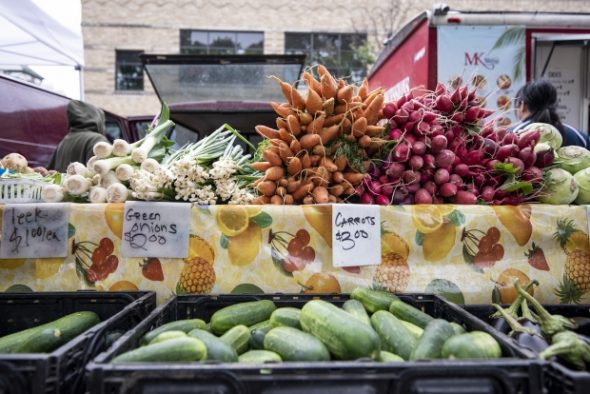Only 10% In State Get Enough Fruits, Vegetables
Survey finds 90% of Wisconsinites don’t get daily recommended value of fruits and vegetables.

Vegetables are displayed on a table Friday, Sep. 11, 2020, at Cameron Park Farmers Market in La Crosse. Angela Major/WPR
Only 1 in 10 Wisconsinites were meeting the daily recommendations for incorporating fruits and vegetables into their diets two years ago, according to a federal study released earlier this month.
The state director of Wisconsin’s Women, Infants and Children, or WIC, nutrition program said increases in benefits during the coronavirus pandemic have made fruits and vegetables more accessible.
The study finds social aspects, finances and even pandemic supply chain issues can contribute to people’s ability to access healthy foods.
Seung Hee Lee is a CDC epidemiologist and an author of the study. She said high cost and limited access have been issues since well before the pandemic.
“We do think that low-income, rural or racial ethnic minority communities often lack convenient places that offer affordable healthy foods,” Lee said.
The study found lower-income Americans had lower rates of success in meeting the CDC’s vegetable recommendations, while men were less likely than women to meet the fruit and vegetable consumption guidelines.
CDC guidelines advise adults should include the equivalent of a cup and a half to two cups of fruits and two to three cups of vegetables in their daily diets. Daily recommendations for children vary depending on their age, gender and level of physical activity.
Some Wisconsin programs aim to make fruits and vegetables more accessible for certain demographics.
Kari Malone is the interim state director of the Wisconsin WIC program. She said American Rescue Plan Act funds have allowed the program to increase its benefits to participants.
Normally, the program provides $9 a month per child and $11 a month per eligible adult, but under the temporary benefits, families are able to receive up to $24 a month for children, $43 a month for pregnant or postpartum individuals, and $47 for parents who are fully breastfeeding.
Malone said many of the families that have reached out to the state’s WIC association have said they “understand that eating fruits and vegetables and getting those nutrients into the diet of not only themselves during pregnancy or postpartum, but to their young children is extremely important for growth and development.”
“The positive influence of this increase is that many of them said, ‘We couldn’t afford to buy many of these before,'” said Malone. “I think that’s key, is the cost.”
“I think reframing the idea of the farmers market as an accessible place to all is really important,” Putzer said. “It’s just another great option for people to get their groceries in a really healthy way, especially during the pandemic, since it’s outside, and it also is a great way to support our farmers. … It’s a win-win across the board, as far as I’m concerned.”
Lee said a diet with adequate fruits and vegetables can help reduce the risk of many major causes of death and illness, including type 2 diabetes, heart disease and certain cancers.
“It’s particularly relevant because these conditions tend to predispose persons to more severe illnesses and deaths from COVID-19,” Lee said.
Lee said all forms of fruits and vegetables count toward the recommended amount of daily fruits and vegetables.
“I think that can really encourage individuals who tend to complain like ‘Oh, it’s too expensive,'” said Lee. “You don’t have to pick the most expensive for some vegetables to be healthy.”
Lee recommended picking canned fruits with low sugar, canned and frozen vegetables with low sodium, and foods with limited additions of salt, butter and cream sauces.
Malone said the additional fruit and vegetable funding for WIC families is currently set to expire March 31. She said it’s important for Congress to take action to keep those funds available.
“I would like to hope that we can get this passed as a permanent amount of money for our families, due to the importance of eating fruits and vegetables in the diet,” Malone said.
Other nutrition assistance options under DHS’ scope include programs for seniors and low-income individuals.
Listen to the WPR link here.
New CDC study finds only 10 percent of Wisconsinites getting daily recommended values of fruits, vegetables was originally published by Wisconsin Public Radio.



















